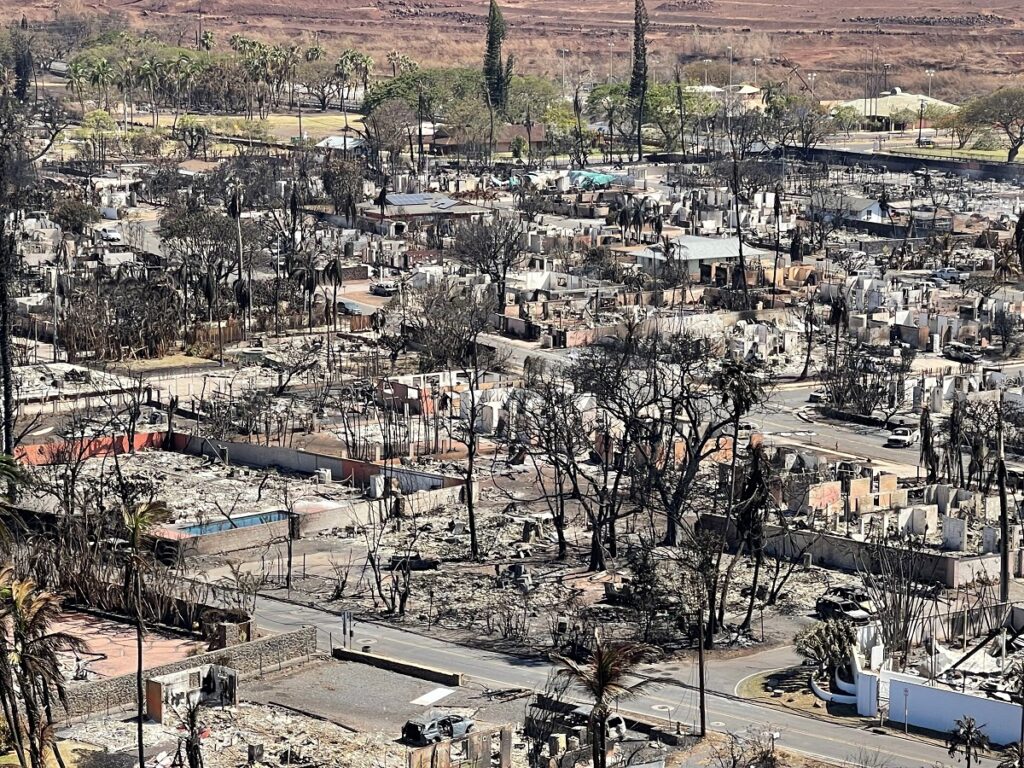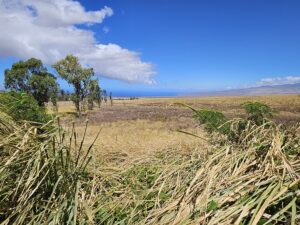
It is becoming likely that Red Flag Warnings will be issued for fire-ravaged Hawaii on Thursday, where the National Weather Service currently has a Fire Weather Watch in effect. While the threat of quick-spreading fires will exist due to the wind conditions, the National Weather Service has said that the winds from this event won’t be nearly as strong as they were on August 8, when fires erupted on Hawaii’s Big Island and on the island of Maui, where fire roared through the community of Lahaina, destroying more than 2,000 buildings and killing more than 115.
Breezy to locally strong trade winds will develop Wednesday and continue into Friday across Hawaii. According to the National Weather Service in Honolulu on the island of Oahu, the moist airmass over the islands this evening is expected to remain in place through Wednesday, before drying out Wednesday night. By Thursday morning, cooler dewpoints are expected to have spread across the state, leading to lower humidity values by the afternoon hours.
According to the National Weather Service, “fire weather” is the use of meteorological parameters such as relative humidity, wind speed and direction, mixing heights, and soil moisture to determine whether conditions are favorable for fire growth and smoke dispersion. Based on the analysis by meteorologists at the Honolulu office of the National Weather Service, a Fire Weather Watch, indicating the possibility of fire weather risks, have been issued for for large parts of each island, especially the western/leeward side areas which could be influenced the most by downslope flows.

In Hawaii, the Fire Weather Watch could be upgraded to a Red Flag Warning when conditions characterized by sustained winds of 20 mph or greater, dry fuels, and afternoon relative humidity values below 45 percent all occur. According to the National Weather Service, these conditions are likely to be in place Thursday.
“It is important to note that the winds for this event WILL NOT be comparable in strength to the August 8, 2023 event, where wind gusts of over 60 mph were observed,” the National Weather Service has pointed out in forecasts and outlooks. “The latest forecast for Wednesday and Thursday is for winds of 15 to 30 mph with gusts of around 40 to 45 mph, with the strongest wind gusts likely downwind/leeward of terrain for Maui County and the Big Island.”
On August 8, fires broke out in the leeward areas of the Big Island near Kohala Ranch, Kawaihae, Waimea, and the Mauna Kea Resort community. While properties were damaged, no lives were lost.
The same wasn’t true on Maui where the death toll stands at 115 with more than 350 individuals unaccounted for. Fires from August 8 continue to burn on Maui; according to the County of Maui, the Lahaina fire is 90% contained after consuming 2,170 acres; the Kula fire is 90% contained with an estimated 202 acres consumed; the Olinda fire is 85% contained, with an estimated 1,081 acres consumed.
The Hawaii State Joint Information Center (JIC) released a statement this afternoon, encouraging Hawai‘i residents and visitors to take steps and exercise care to reduce the risks of fires as dry and gusty conditions move across the state this week. JIC says the state and its partners are coordinating additional firefighting resources across the area to meet the increased risk, but the public also plays a vital part in reducing harm.
“This is a kākou situation, where we all have to do our part to protect our communities,” said James Barros, Administrator of Hawai‘i Emergency Management Agency (HI-EMA).
The JIC recommends that residents pursue these tips to reduce the risk of wildfires during this period of heightened risk:
- Use extreme caution with flame or heat sources outdoors. Do not burn items outdoors and be careful when using power tools or garden equipment that could strike sparks from stones. Do not allow chains, or other items that could produce sparks, to drag from vehicles.
- Never throw cigarette butts or other burning items from a vehicle or into vegetation.
- Never park on dry grass or vegetation; vehicle exhaust systems quickly become hot enough to start a blaze.
- Clear dry vegetation and other flammable items away from around structures. The idea is to create at least five feet of “fire-free defensible space” around them to make it less likely that embers will spread a fire.
- Make sure your roof and gutters are free of dead leaves and other fuel that could give fire an easy place to start.
- Trim tall vegetation around trees that could act as a “ladder” and allow flames to climb into the tree canopy and spread rapidly. Prune trees and shrubs near structures and to create separation within the tree canopy.
Ahead of another fire weather event in Hawaii, the latest Drought Monitor maps show bad news: the entire state is abnormally dry or worse. Moderate to severe drought conditions co-exist with the current Fire Weather Watch Zone. #HIwx pic.twitter.com/wH3K7YWa82
— the Weatherboy (@theWeatherboy) August 30, 2023
On the Big Island of Hawaii, Hawaii County Civil Defense released a public statement via email, text message, and via broadcast channels to people there: “Hawaii Island residents, please avoid all outdoor activity that involves an open flame or parking of vehicles on dry grass after travel. Please take this time to secure outdoor items and to mitigate fire safety concerns on your property.”
On Maui, the Maui Fire Department released tips to people there to reduce the risk of additional fires:
- Refrain from ALL outdoor burning, including cooking
- Avoid the use of mechanized equipment outdoors, including the use of yardwork equipment
- Do not drive your vehicle in dry, tall grass. The underside of your vehicle is hot and can easily ignite grasses from your exhaust muffler
- Ensure trailer chains do not drag on the ground
- Be aware of wind direction and gusts that could spread fire rapidly
- Have an escape route to a clear area safe from rapid-fire spread
Hawaii is under the influence of a weather pattern tied to El Nino, in which creates unusually dry conditions over the summer and especially the autumn months there. Worsening drought conditions are drying-out tens of thousands of acres of flammable, invasive wild grasses that cover the islands, setting the stage for danger whenever fire weather conditions arrive.